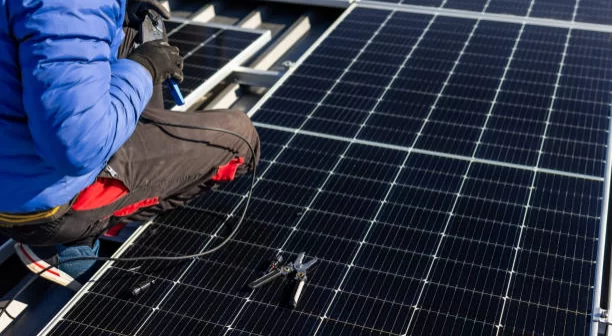Solar Panels and Battery Bank vs Energy Storage Systems: In-Depth Analysis of Differences and Applications
In today’s pursuit of sustainable energy development and efficient utilization,solar panels and battery bank and energy storage systems have become prominent solutions in the energy sector. However, despite their shared goal of meeting energy storage and supply needs, they differ significantly in several key aspects.
1. Differences in Energy Sources
- Solar panels and battery bank rely relatively on a single energy source, primarily converting solar energy into electricity through solar panels. This means their energy supply stability largely depends on weather conditions and sunlight duration. On sunny days, solar panels efficiently generate electricity stored in batteries; however, their power generation capability is significantly reduced during cloudy or nighttime conditions.
- In contrast, energy storage systems exhibit higher flexibility and diversity in energy sources. They can not only receive electricity from solar panels but also integrate multiple sources such as wind energy, hydropower, and electricity purchased from the grid. This multi-source input characteristic enhances their adaptability in energy acquisition, enabling better adaptation to varying environmental and energy market conditions.
2. Differences in Structural Composition
- Solar panels and battery bankhave a relatively straightforward structure. They typically consist of core components like solar panels, battery packs, controllers, and inverters. Solar panels convert sunlight into direct current (DC) electricity, controllers regulate current and voltage to protect batteries, and inverters convert DC electricity into alternating current (AC) for user consumption.
- Energy storage systems, on the other hand, feature a more complex and sophisticated composition. In addition to large-capacity battery packs, they are equipped with advanced Energy Management Systems (EMS), multiple types of input and output interfaces, smart monitoring devices, and safety protection devices. EMS optimizes scheduling for various energy inputs, manages battery charging and discharging, and coordinates communication with external systems to ensure efficient operation and safety of the energy storage system.
3. Emphasis on Application Scenarios
- Due to their structural and energy source characteristics, solar panels and battery bank are more suitable for specific small-scale applications. For instance, in remote rural areas or standalone residential homes with good solar resources and relatively stable electricity demands,solar panels and battery bank can provide reliable electricity for basic living needs. Moreover, for temporary outdoor venues such as campsites or field workstations, the portability and easy installation of solar panels with battery kits make them an ideal choice to meet short-term electricity needs.
- Energy storage systems are inclined towards meeting large-scale and complex energy demands due to their robust functionality and flexible configurations. In industrial settings, factories can use energy storage systems to balance electricity fluctuations during production, reduce electricity costs, and provide emergency backup power during grid outages. Large commercial facilities like shopping malls and data centers can optimize energy storage and distribution using energy storage systems, enhancing energy utilization efficiency and power supply reliability. Additionally, in renewable energy generation fields, energy storage systems can store and regulate electricity generated from unstable sources such as wind and solar energy to achieve more stable power outputs.
4. Flexibility Comparison
- In terms of expansion and adjustment, solar panels with battery kits have relatively limited flexibility. Once installed, increasing the number of solar panels or battery capacity often requires significant modification and investment. Moreover, due to their design focusing primarily on specific initial requirements, integrating different types of energy and adding new functionalities later may pose significant technical challenges.
- Energy storage systems demonstrate a clear advantage in this regard. They typically feature modular designs that allow users to gradually increase battery capacity or expand input-output interfaces based on actual needs. Furthermore, software and control systems of energy storage systems are easier to upgrade and optimize to accommodate new energy management strategies and technological developments. Moreover, energy storage systems exhibit higher openness and compatibility in integrating with other energy systems and devices, enabling better integration into complex energy networks.
5. Cost Considerations
- In terms of costs, solar panels with battery kits may have an advantage for small-scale applications, especially in initial investments. If a user’s energy demand is small and the system’s complexity requirements are low, solar panels with battery kits can provide a basic energy solution at a relatively lower price.
- However, when dealing with large-scale energy storage and complex application scenarios, energy storage systems may offer more pronounced cost-effectiveness. Despite potentially higher initial procurement costs, efficient energy management, multi-source integration capabilities, and long-term lifespan of energy storage systems can bring significant economic benefits and value to users during operation.
6. Efficiency and Performance Comparison
- The efficiency and performance of solar panels with battery kits depend primarily on the conversion efficiency of solar panels and the charging and discharging performance of batteries. Due to their relatively simple structure and single energy input, their potential in energy management and optimization is relatively limited.
- Energy storage systems, leveraging advanced energy management systems and complex control strategies, can achieve more precise battery charging and discharging control, dynamic allocation of energy inputs, and collaborative optimization with external systems. This typically results in superior performance in energy utilization efficiency, response speed, and adaptability to complex loads.
In summary, while both solar panels with battery kits and energy storage systems play important roles in the field of energy storage, they differ significantly in energy sources, structural composition, application scenarios, flexibility, costs, and efficiency performance. When choosing between them, users should consider factors such as specific energy needs, energy conditions, and budget to determine the most suitable energy storage solution. Whether pursuing simple and convenient small-scale energy self-sufficiency or aiming for large-scale energy optimization management and efficient utilization, suitable choices can be found in these two technologies, contributing to the construction of a sustainable energy future.

